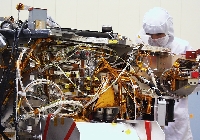 |
|
The Mars Microphone LIDAR and Microphone Team |
Since the rate at which we can acquire data will be limited, it will take several days, maybe even a week, to retrieve one 10 second sound clip. The device has an internal memory which will store the sounds that will be transmitted to Earth. The construction of the microphone is mainly from "off the shelf" technology, very few of the components were especially designed for this mission. The actual microphone itself is one like those typically used in hearing aids.
The photo on this page shows engineers integrating the Planetary Society's Mars Microphone into the LIDAR hardware (photo: NASA/JPL). Source: "The Mars Microphone: Ready to Go," by Greg Delory Technical details: The following Acrobat documents (PDF files) provide more technical details about the Mars Microphone. To read these files, make sure you have Adobe Acrobat Reader loaded on your computer. If you don't have this program loaded, visit the Adobe Acrobat web site to download this free program.
|
The Planetary Society's A Celebration of Planetary Exploration |
| Home | Mars Climate Orbiter | Mars Polar Lander | Deep Space 2 Microprobes |
For questions or comments on this website please refer to our list of contacts.
 The Mars Microphone underwent testing to assure that it
could withstand the rigors of a planetary mission. The level of radiation is higher
in space and on Mars compared to Earth and the electrical components are sensitive to damage from this radiation exposure. There were no problems with the microphone when it was tested under these conditions, there were also no problems when thermal tests were
conducted.
The Mars Microphone underwent testing to assure that it
could withstand the rigors of a planetary mission. The level of radiation is higher
in space and on Mars compared to Earth and the electrical components are sensitive to damage from this radiation exposure. There were no problems with the microphone when it was tested under these conditions, there were also no problems when thermal tests were
conducted.